inflation pressure LEXUS RX350 2011 Owners Manual
[x] Cancel search | Manufacturer: LEXUS, Model Year: 2011, Model line: RX350, Model: LEXUS RX350 2011Pages: 821, PDF Size: 13.27 MB
Page 68 of 821
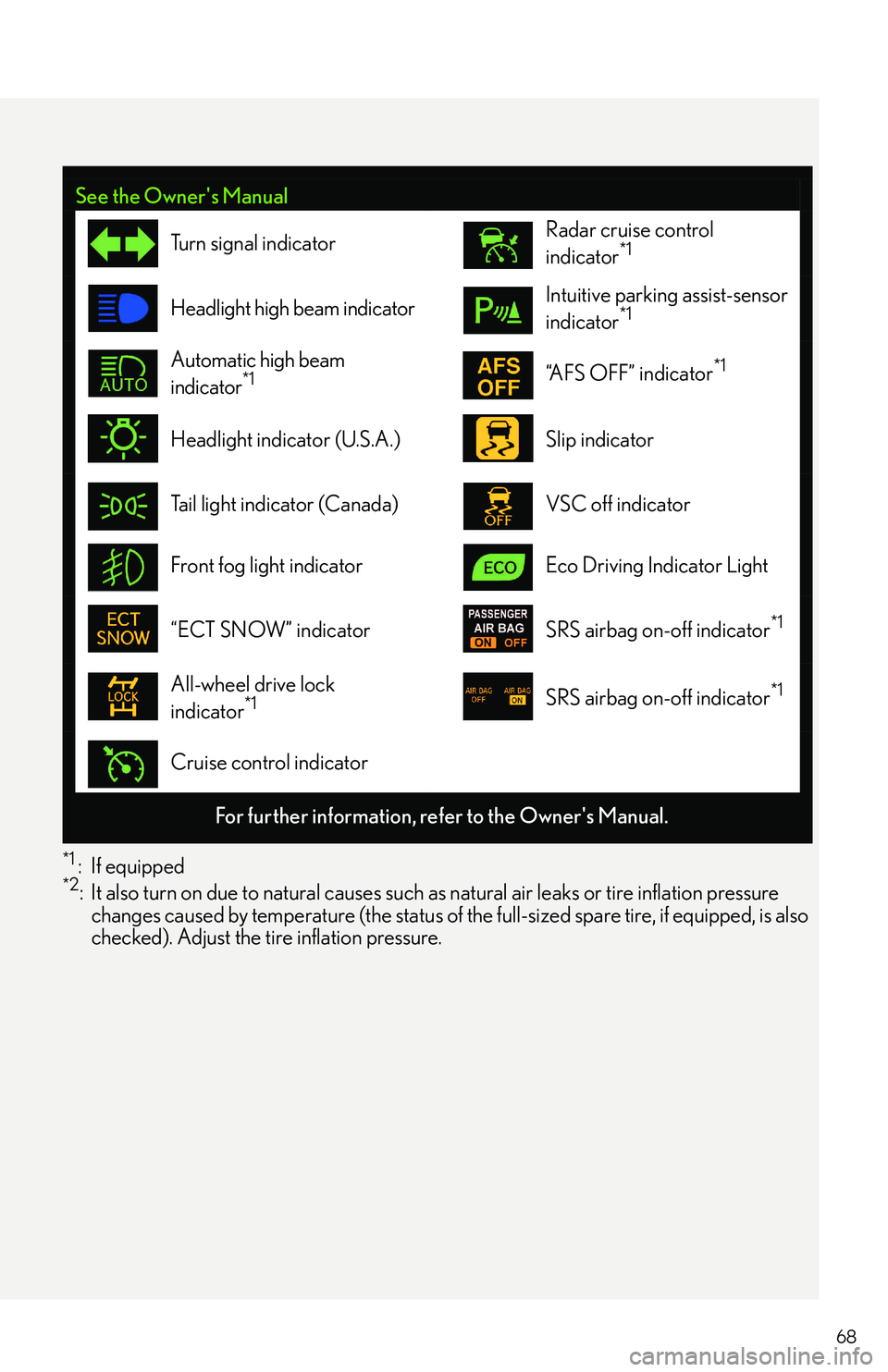
68
*1 : If equipped*2: It also turn on due to natural causes such as natural air leaks or tire inflation pressure
changes caused by temperature (the status of the full-sized spare tire, if equipped, is also checked). Adjust the tire inflation pressure.
See the Owner's Manual
Tu r n s i g n a l i n d i c a t o rRadar cruise control
indicator*1
Headlight high beam indicatorIntuitive parking assist-sensor
indicator*1
Automatic high beam
indicator*1“AFS OFF” indicator*1
Headlight indicator (U.S.A.)Slip indicator
Tail light indicator (Canada)VSC off indicator
Front fog light indicatorEco Driving Indicator Light
“ECT SNOW” indicatorSRS airbag on-off indicator*1
All-wheel drive lock
indicator*1SRS airbag on-off indicator*1
Cruise control indicator
For further information, refer to the Owner's Manual.
Page 79 of 821
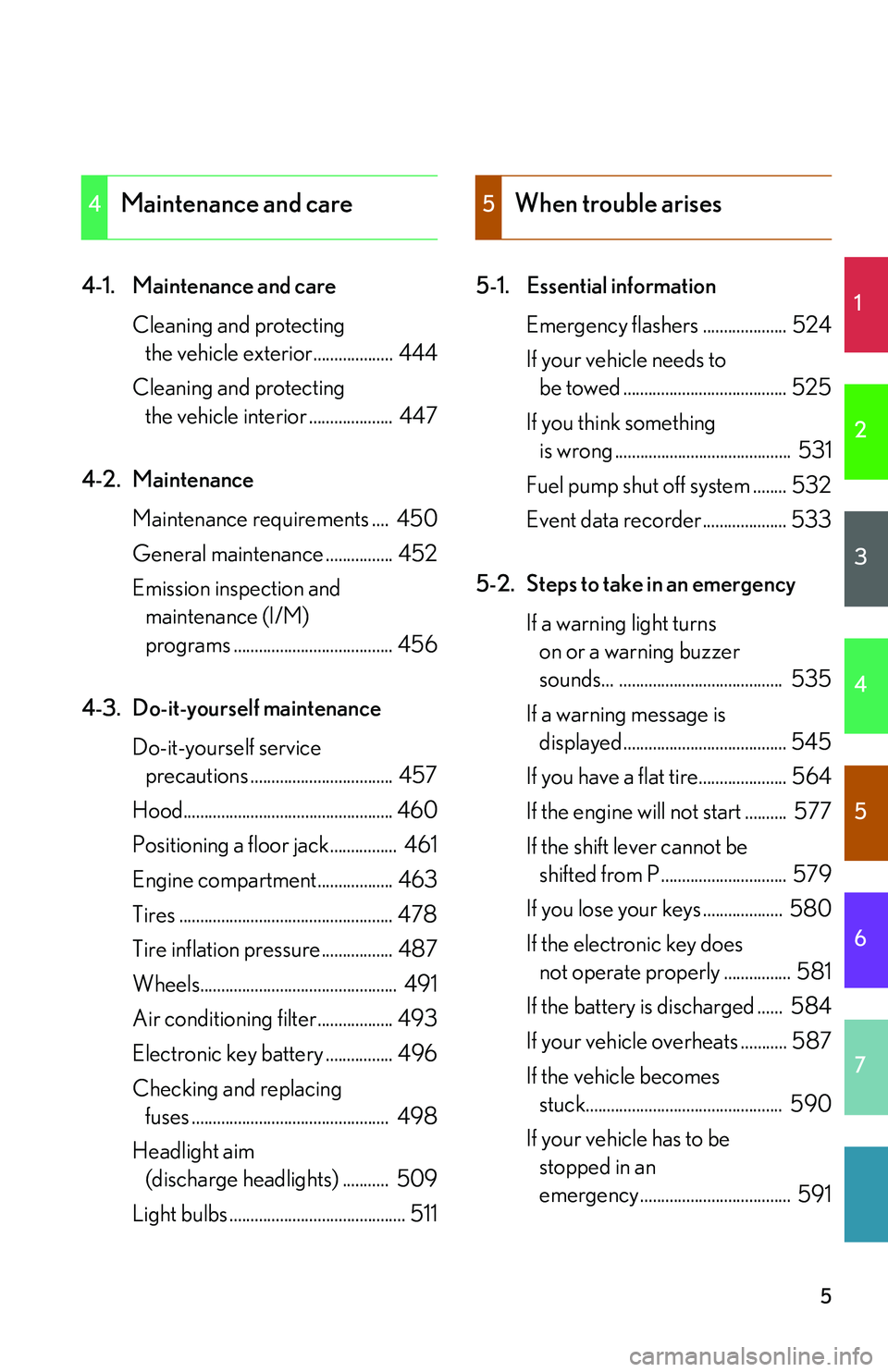
1
2
3
4
5
6
7
5
4-1. Maintenance and care
Cleaning and protecting
the vehicle exterior................... 444
Cleaning and protecting
the vehicle interior .................... 447
4-2. Maintenance
Maintenance requirements .... 450
General maintenance ................ 452
Emission inspection and
maintenance (I/M)
programs ...................................... 456
4-3. Do-it-yourself maintenance
Do-it-yourself service
precautions .................................. 457
Hood.................................................. 460
Positioning a floor jack................ 461
Engine compartment.................. 463
Tires ................................................... 478
Tire inflation pressure ................. 487
Wheels............................................... 491
Air conditioning filter.................. 493
Electronic key battery ................ 496
Checking and replacing
fuses ............................................... 498
Headlight aim
(discharge headlights) ........... 509
Light bulbs .......................................... 511
5-1. Essential information
Emergency flashers .................... 524
If your vehicle needs to
be towed ....................................... 525
If you think something
is wrong .......................................... 531
Fuel pump shut off system ........ 532
Event data recorder.................... 533
5-2. Steps to take in an emergency
If a warning light turns
on or a warning buzzer
sounds... ....................................... 535
If a warning message is
displayed....................................... 545
If you have a flat tire..................... 564
If the engine will not start .......... 577
If the shift lever cannot be
shifted from P .............................. 579
If you lose your keys ................... 580
If the electronic key does
not operate properly ................ 581
If the battery is discharged ...... 584
If your vehicle overheats ........... 587
If the vehicle becomes
stuck............................................... 590
If your vehicle has to be
stopped in an
emergency .................................... 591
4Maintenance and care5When trouble arises
Page 83 of 821
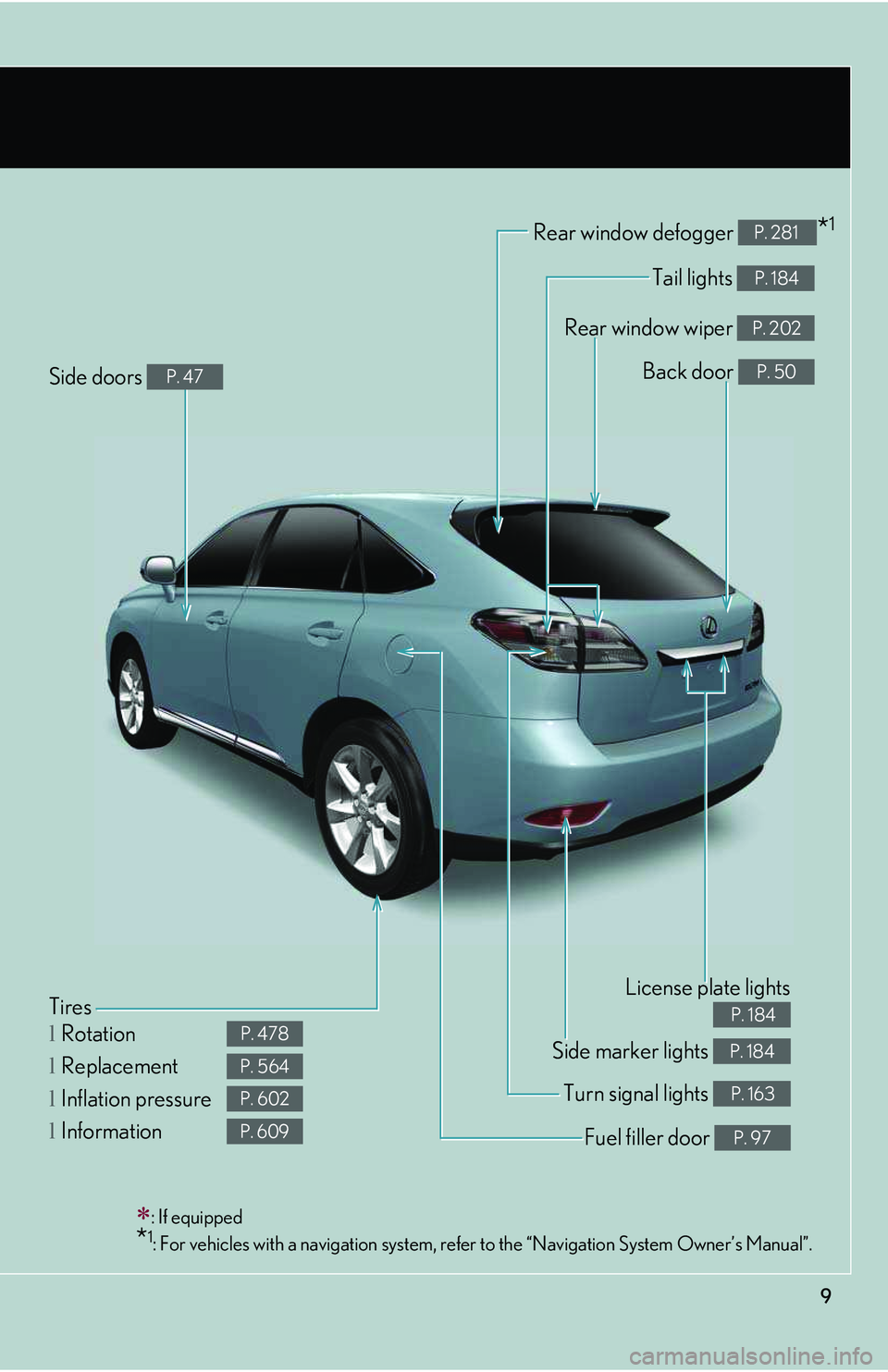
9
Tail lights P. 184
Rear window defogger *1P. 281
Rear window wiper P. 202
Tires
lRotation
lReplacement
lInflation pressure
lInformation
P. 478
P. 564
P. 602
P. 609
Side marker lights P. 184
Fuel filler door P. 97
Turn signal lights P. 163
License plate lights
P. 184
Side doors P. 47Back door P. 50
�∗: If equipped
*1: For vehicles with a navigation system, refer to the “Navigation System Owner’s Manual”.
Page 308 of 821
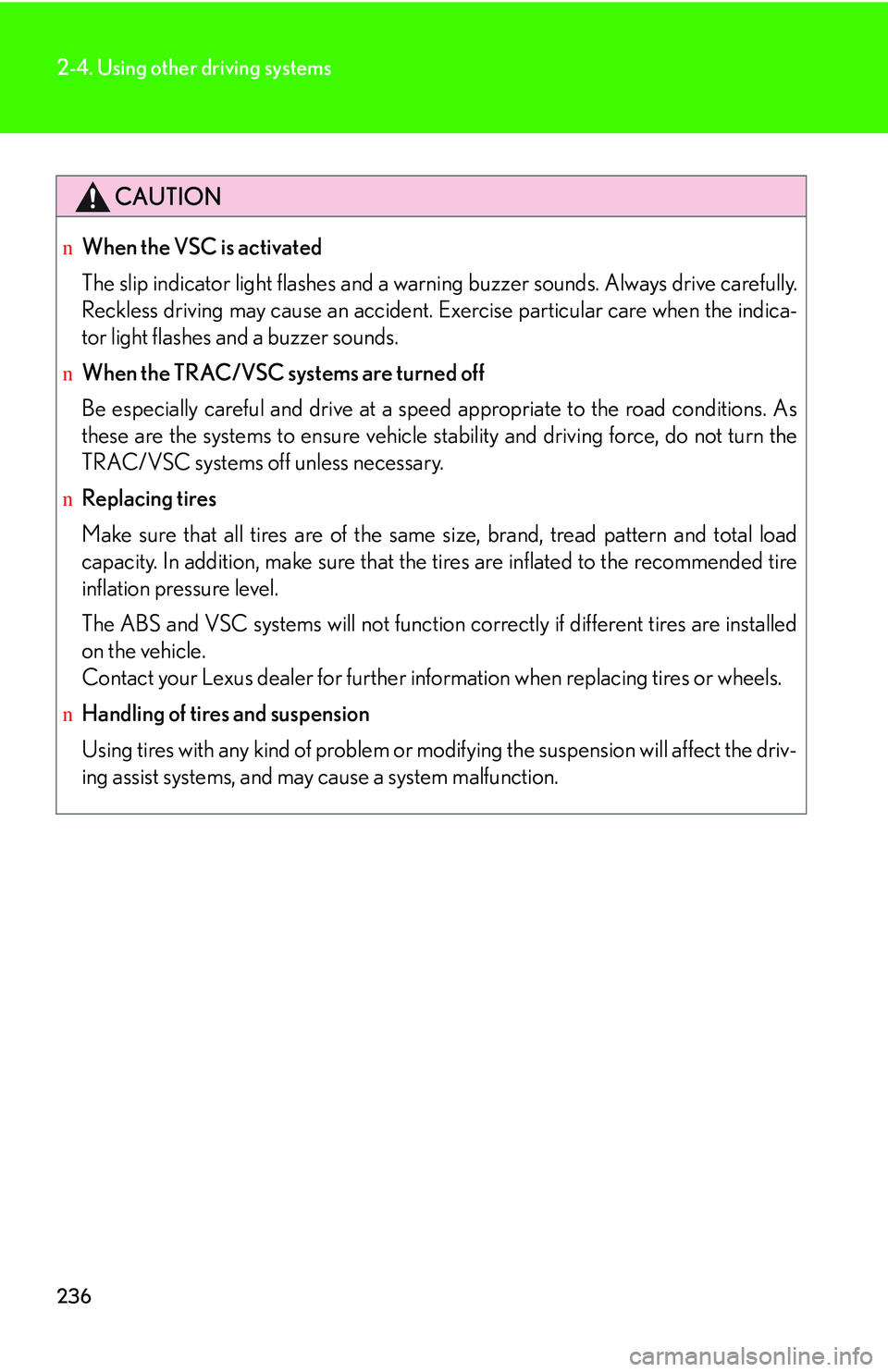
236
2-4. Using other driving systems
CAUTION
nWhen the VSC is activated
The slip indicator light flashes and a warning buzzer sounds. Always drive carefully.
Reckless driving may cause an accident. Exercise particular care when the indica-
tor light flashes and a buzzer sounds.
nWhen the TRAC/VSC systems are turned off
Be especially careful and drive at a speed appropriate to the road conditions. As
these are the systems to ensure vehicle stability and driving force, do not turn the
TRAC/VSC systems off unless necessary.
nReplacing tires
Make sure that all tires are of the same size, brand, tread pattern and total load
capacity. In addition, make sure that the tires are inflated to the recommended tire
inflation pressure level.
The ABS and VSC systems will not function correctly if different tires are installed
on the vehicle.
Contact your Lexus dealer for further information when replacing tires or wheels.
nHandling of tires and suspension
Using tires with any kind of problem or modifying the suspension will affect the driv-
ing assist systems, and may cause a system malfunction.
Page 549 of 821
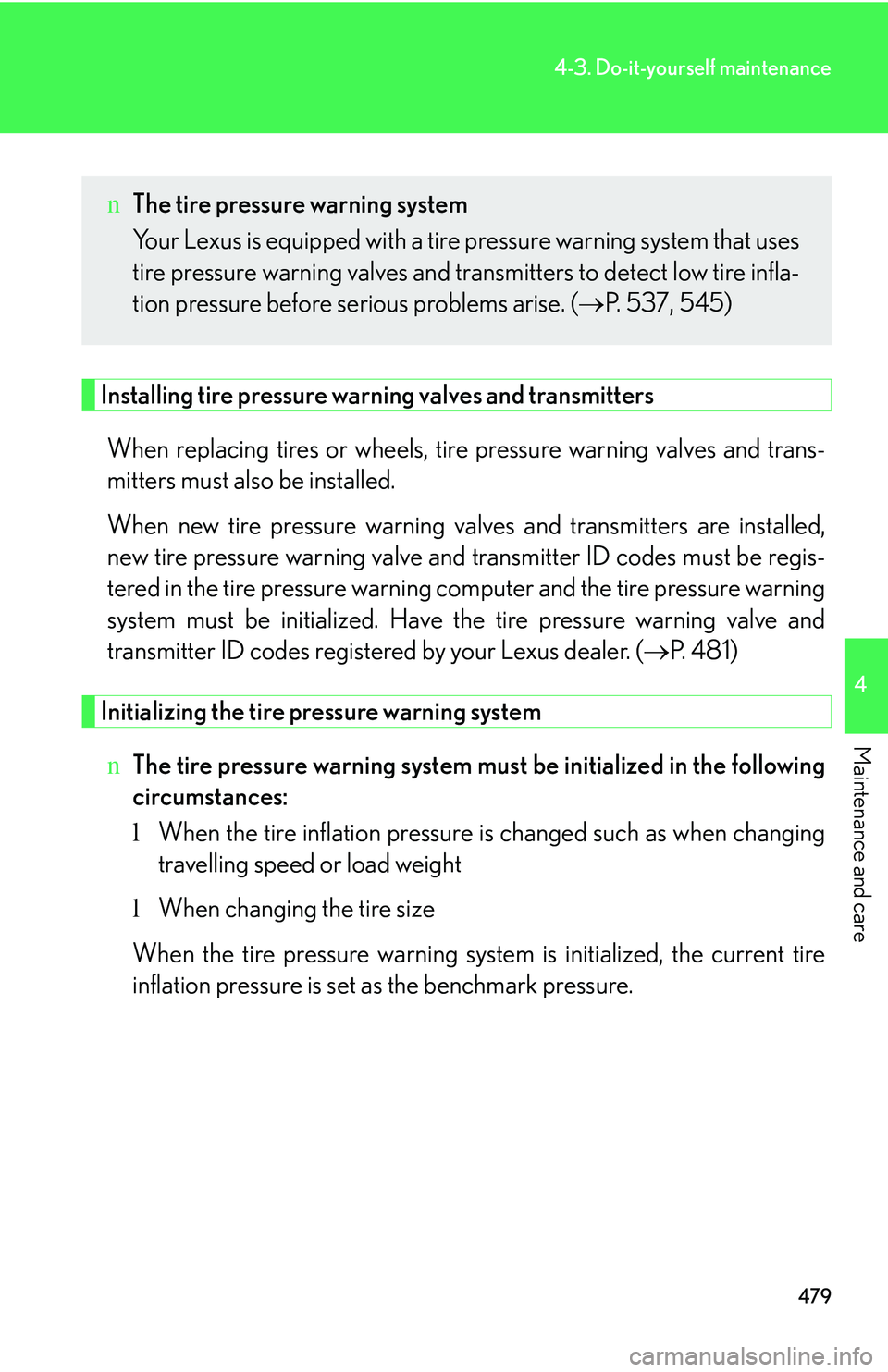
479
4-3. Do-it-yourself maintenance
4
Maintenance and care
Installing tire pressure warning valves and transmitters
When replacing tires or wheels, tire pressure warning valves and trans-
mitters must also be installed.
When new tire pressure warning valves and transmitters are installed,
new tire pressure warning valve and transmitter ID codes must be regis-
tered in the tire pressure warning computer and the tire pressure warning
system must be initialized. Have the tire pressure warning valve and
transmitter ID codes registered by your Lexus dealer. (�→P. 4 8 1 )
Initializing the tire pressure warning system
nThe tire pressure warning system must be initialized in the following
circumstances:
lWhen the tire inflation pressure is changed such as when changing
travelling speed or load weight
lWhen changing the tire size
When the tire pressure warning system is initialized, the current tire
inflation pressure is set as the benchmark pressure.
nThe tire pressure warning system
Your Lexus is equipped with a tire pressure warning system that uses
tire pressure warning valves and transmitters to detect low tire infla-
tion pressure before serious problems arise. (�→P. 537, 545)
Page 550 of 821
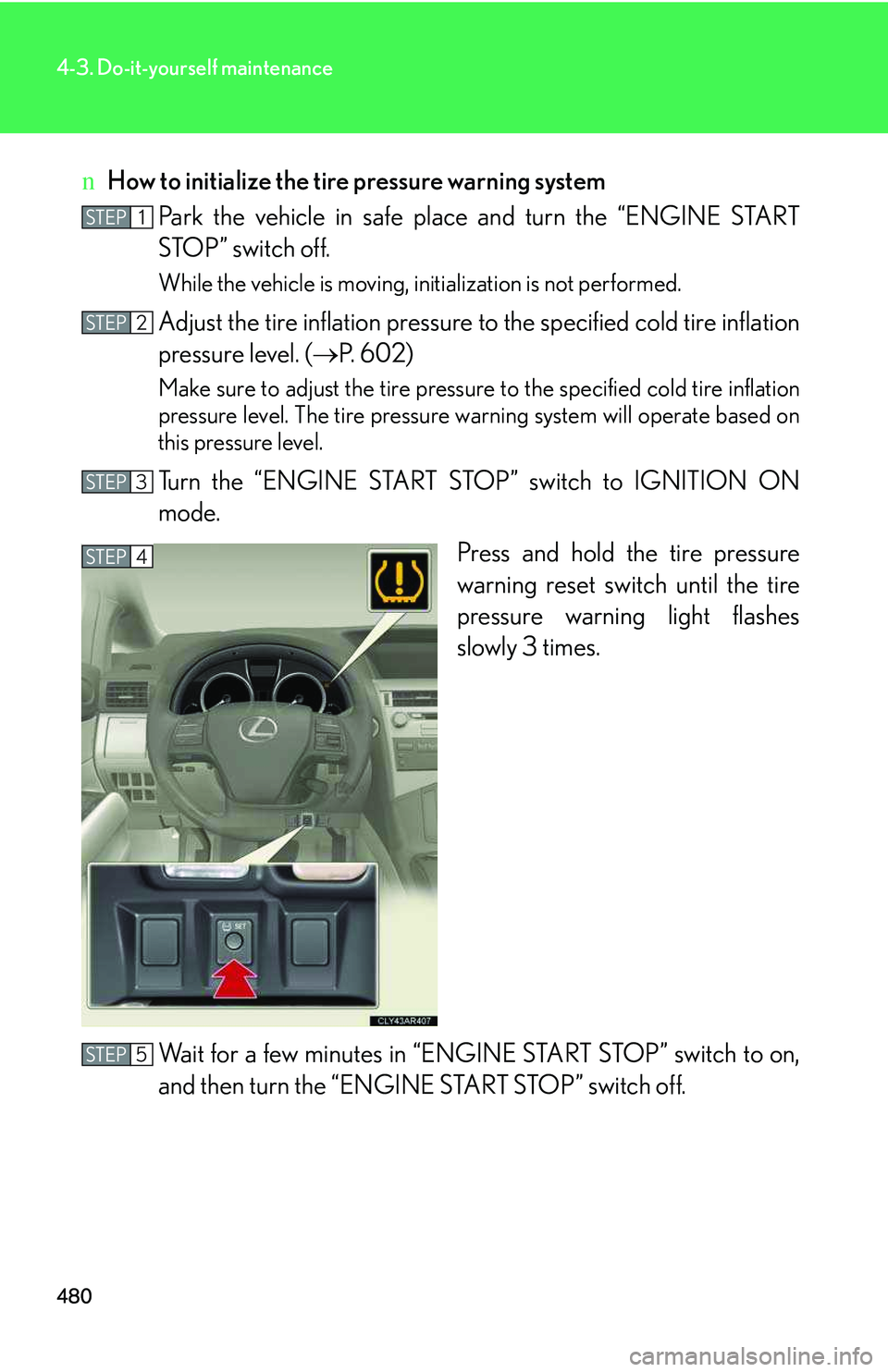
480
4-3. Do-it-yourself maintenance
nHow to initialize the tire pressure warning system
Park the vehicle in safe place and turn the “ENGINE START
STOP” switch off.
While the vehicle is moving, initialization is not performed.
Adjust the tire inflation pressure to the specified cold tire inflation
pressure level. (�→P. 6 0 2 )
Make sure to adjust the tire pressure to the specified cold tire inflation
pressure level. The tire pressure warning system will operate based on
this pressure level.
Turn the “ENGINE START STOP” switch to IGNITION ON
mode.
Press and hold the tire pressure
warning reset switch until the tire
pressure warning light flashes
slowly 3 times.
Wait for a few minutes in “ENGINE START STOP” switch to on,
and then turn the “ENGINE START STOP” switch off.
STEP1
STEP2
STEP3
STEP4
STEP5
Page 552 of 821
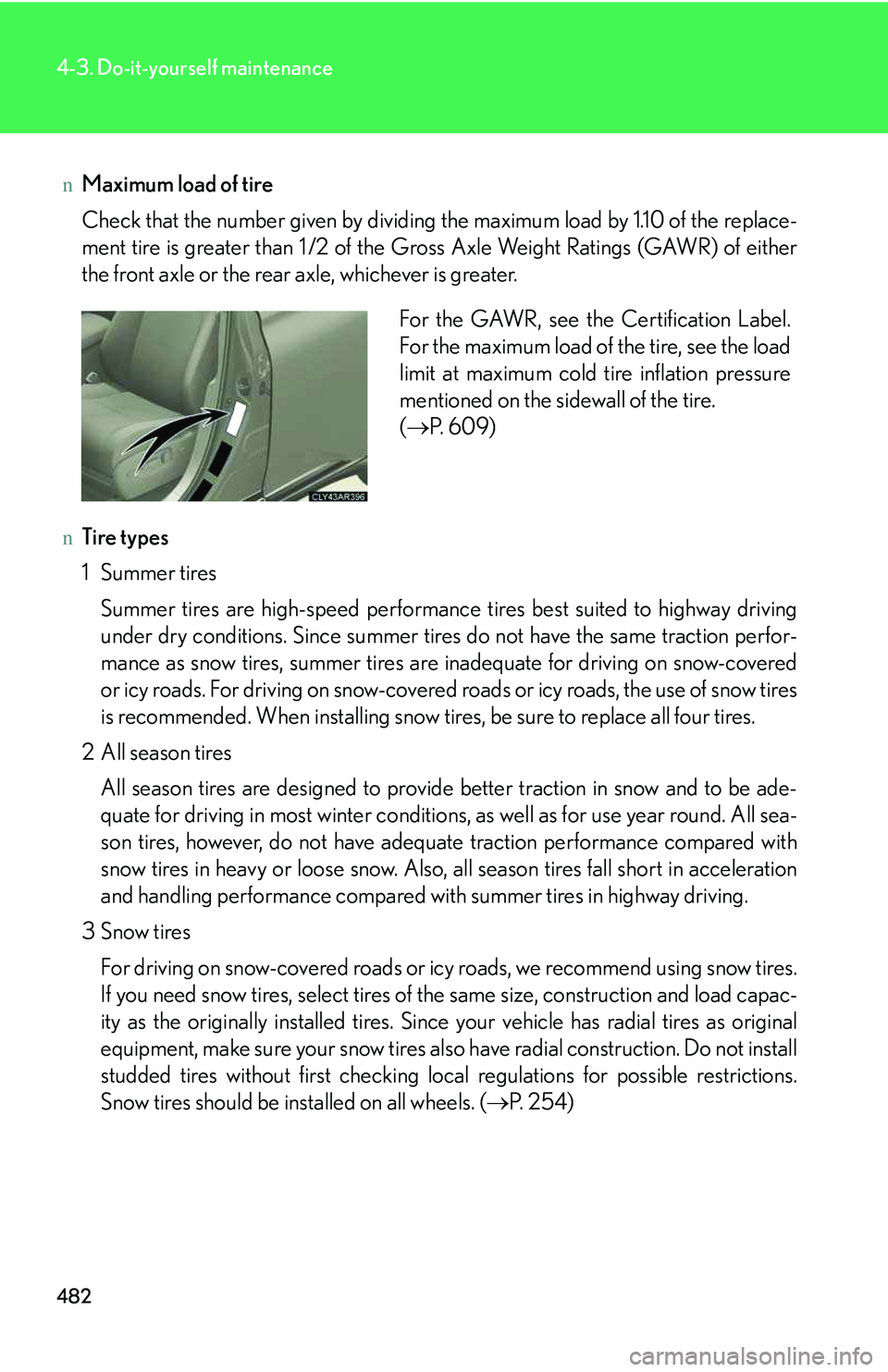
482
4-3. Do-it-yourself maintenance
nMaximum load of tire
Check that the number given by dividing the maximum load by 1.10 of the replace-
ment tire is greater than 1 /2 of the Gross Axle Weight Ratings (GAWR) of either
the front axle or the rear axle, whichever is greater.
nTire types
1Summer tires
Summer tires are high-speed performance tires best suited to highway driving
under dry conditions. Since summer tires do not have the same traction perfor-
mance as snow tires, summer tires are inadequate for driving on snow-covered
or icy roads. For driving on snow-covered roads or icy roads, the use of snow tires
is recommended. When installing snow tires, be sure to replace all four tires.
2 All season tires
All season tires are designed to provide better traction in snow and to be ade-
quate for driving in most winter conditions, as well as for use year round. All sea-
son tires, however, do not have adequate traction performance compared with
snow tires in heavy or loose snow. Also, all season tires fall short in acceleration
and handling performance compared with summer tires in highway driving.
3Snow tires
For driving on snow-covered roads or icy roads, we recommend using snow tires.
If you need snow tires, select tires of the same size, construction and load capac-
ity as the originally installed tires. Since your vehicle has radial tires as original
equipment, make sure your snow tires also have radial construction. Do not install
studded tires without first checking local regulations for possible restrictions.
Snow tires should be installed on all wheels. (�→P. 2 5 4 )
For the GAWR, see the Certification Label.
For the maximum load of the tire, see the load
limit at maximum cold tire inflation pressure
mentioned on the sidewall of the tire.
(�→P. 6 0 9 )
Page 553 of 821
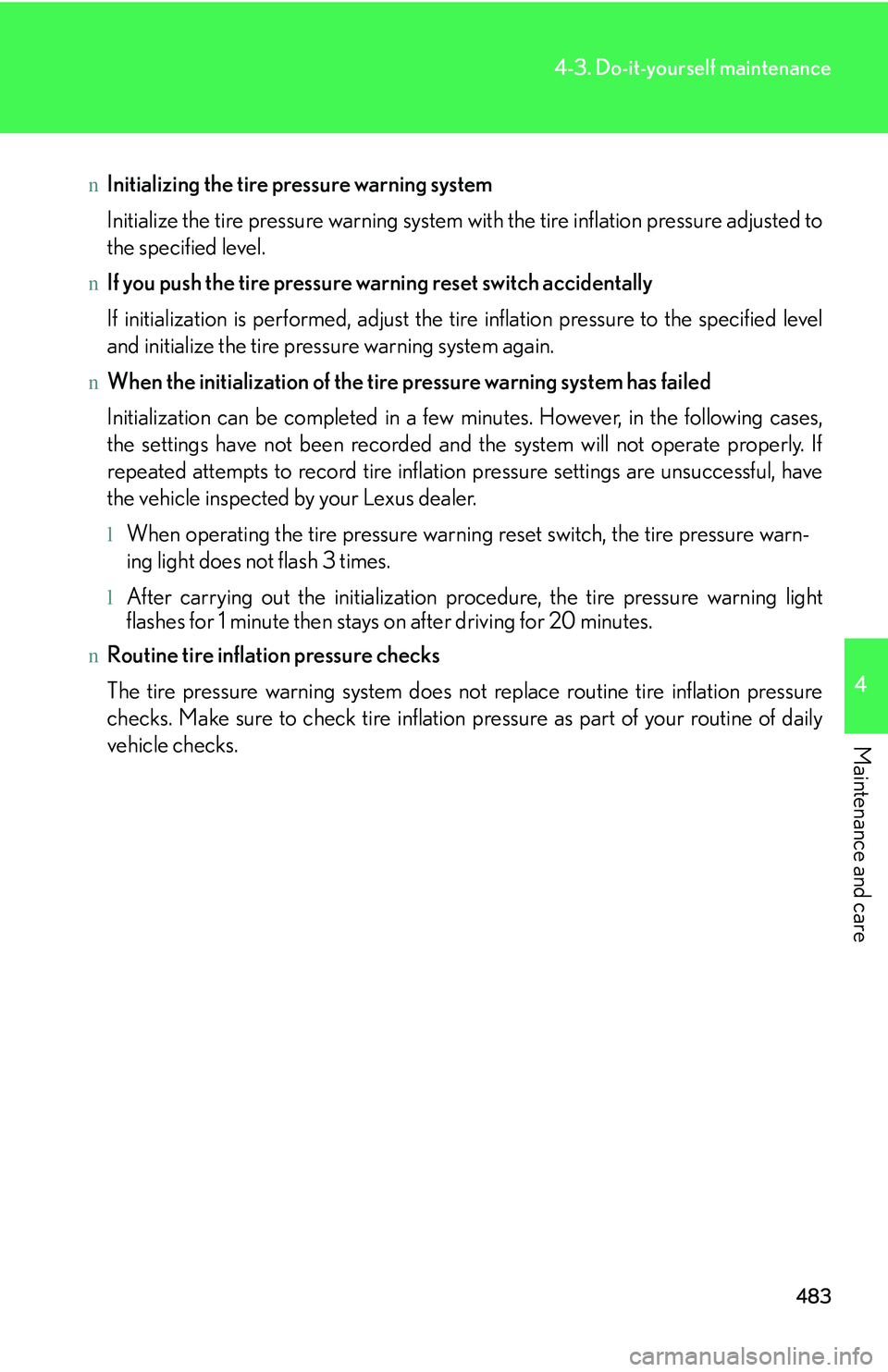
483
4-3. Do-it-yourself maintenance
4
Maintenance and care
nInitializing the tire pressure warning system
Initialize the tire pressure warning system with the tire inflation pressure adjusted to
the specified level.
nIf you push the tire pressure warning reset switch accidentally
If initialization is performed, adjust the tire inflation pressure to the specified level
and initialize the tire pressure warning system again.
nWhen the initialization of the tire pressure warning system has failed
Initialization can be completed in a few minutes. However, in the following cases,
the settings have not been recorded and the system will not operate properly. If
repeated attempts to record tire inflation pressure settings are unsuccessful, have
the vehicle inspected by your Lexus dealer.
lWhen operating the tire pressure warning reset switch, the tire pressure warn-
ing light does not flash 3 times.
lAfter carrying out the initialization procedure, the tire pressure warning light
flashes for 1 minute then stays on after driving for 20 minutes.
nRoutine tire inflation pressure checks
The tire pressure warning system does not replace routine tire inflation pressure
checks. Make sure to check tire inflation pressure as part of your routine of daily
vehicle checks.
Page 555 of 821
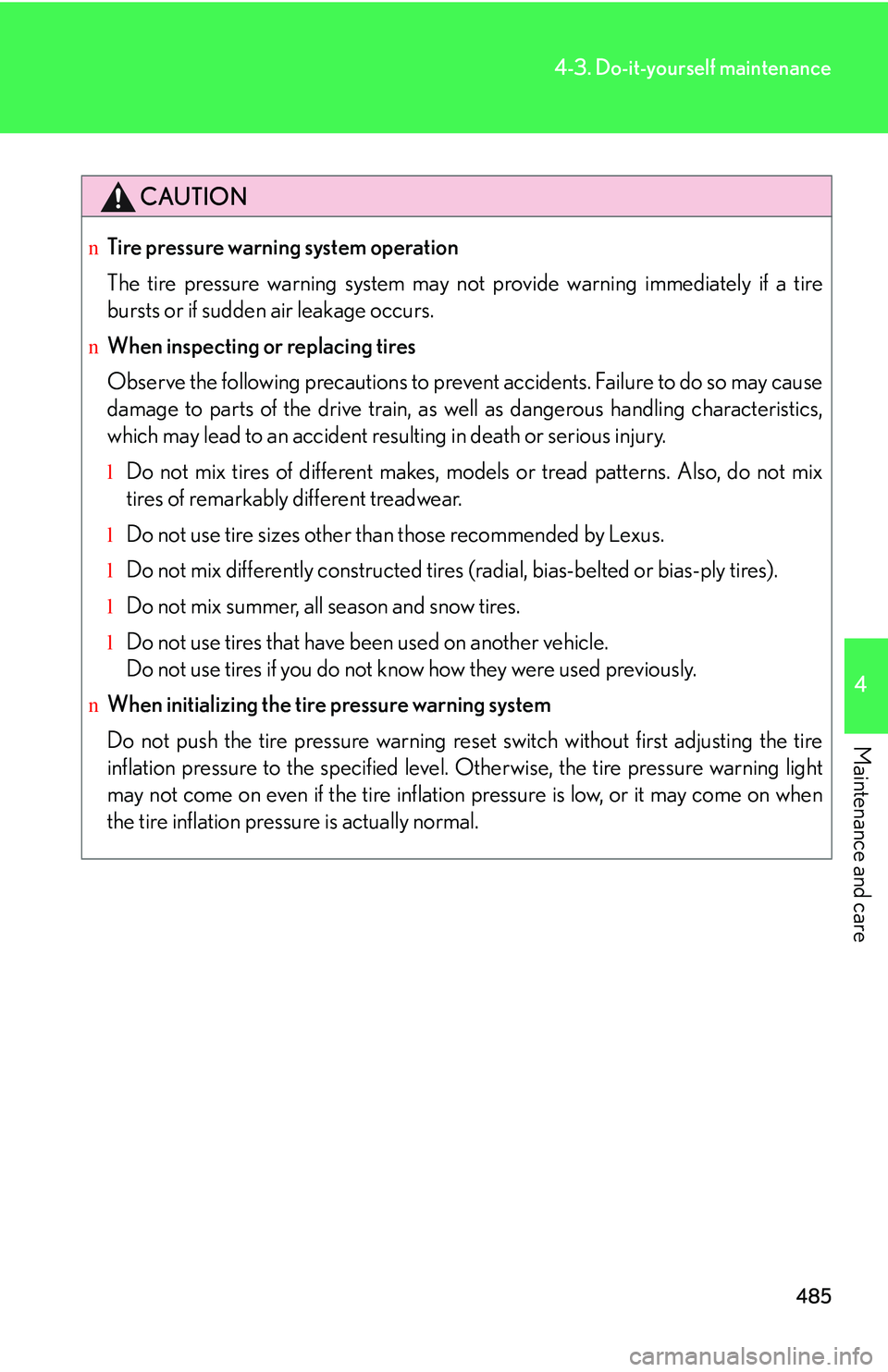
485
4-3. Do-it-yourself maintenance
4
Maintenance and care
CAUTION
nTire pressure warning system operation
The tire pressure warning system may not provide warning immediately if a tire
bursts or if sudden air leakage occurs.
nWhen inspecting or replacing tires
Observe the following precautions to prevent accidents. Failure to do so may cause
damage to parts of the drive train, as well as dangerous handling characteristics,
which may lead to an accident resulting in death or serious injury.
lDo not mix tires of different makes, models or tread patterns. Also, do not mix
tires of remarkably different treadwear.
lDo not use tire sizes other than those recommended by Lexus.
lDo not mix differently constructed tires (radial, bias-belted or bias-ply tires).
lDo not mix summer, all season and snow tires.
lDo not use tires that have been used on another vehicle.
Do not use tires if you do not know how they were used previously.
nWhen initializing the tire pressure warning system
Do not push the tire pressure warning reset switch without first adjusting the tire
inflation pressure to the specified level. Otherwise, the tire pressure warning light
may not come on even if the tire inflation pressure is low, or it may come on when
the tire inflation pressure is actually normal.
Page 556 of 821
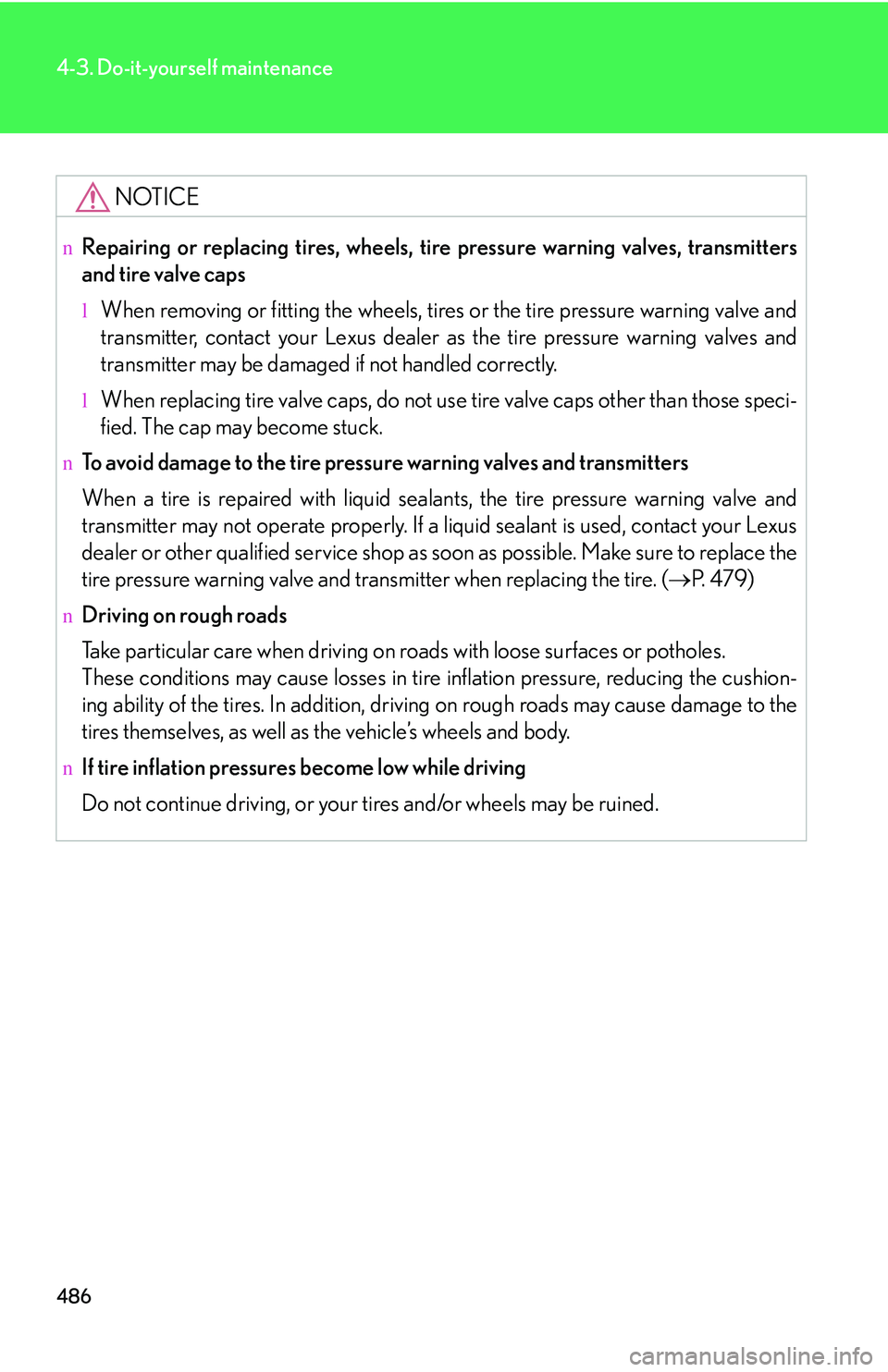
486
4-3. Do-it-yourself maintenance
NOTICE
nRepairing or replacing tires, wheels, tire pressure warning valves, transmitters
and tire valve caps
lWhen removing or fitting the wheels, tires or the tire pressure warning valve and
transmitter, contact your Lexus dealer as the tire pressure warning valves and
transmitter may be damaged if not handled correctly.
lWhen replacing tire valve caps, do not use tire valve caps other than those speci-
fied. The cap may become stuck.
nTo avoid damage to the tire pressure warning valves and transmitters
When a tire is repaired with liquid sealants, the tire pressure warning valve and
transmitter may not operate properly. If a liquid sealant is used, contact your Lexus
dealer or other qualified service shop as soon as possible. Make sure to replace the
tire pressure warning valve and transmitter when replacing the tire. (�→P. 4 7 9 )
nDriving on rough roads
Take particular care when driving on roads with loose surfaces or potholes.
These conditions may cause losses in tire inflation pressure, reducing the cushion-
ing ability of the tires. In addition, driving on rough roads may cause damage to the
tires themselves, as well as the vehicle’s wheels and body.
nIf tire inflation pressures become low while driving
Do not continue driving, or your tires and/or wheels may be ruined.